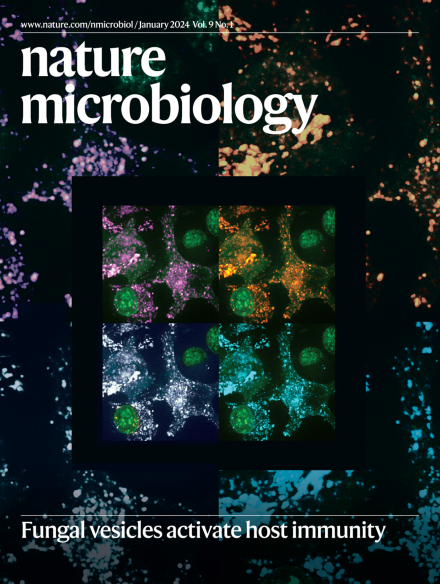Discovery and artificial intelligence-guided mechanistic elucidation of a narrow-spectrum antibiotic.
IF 19.4
1区 生物学
Q1 MICROBIOLOGY
引用次数: 0
Abstract
Current clinical antibiotics are largely broad-spectrum agents that can alter the gut microbiome and promote colonization by Enterobacteriaceae, which are often drug resistant. This includes adherent-invasive Escherichia coli (AIEC), particularly in patients with inflammatory bowel disease, in which dysbiosis creates a niche for this pathogen to colonize. There is an urgent and unmet need for novel narrow-spectrum and microbiome-sparing antibiotics. Here we screened 10,747 bioactive small molecules for antibacterial activity against AIEC and discovered enterololin, an antibacterial compound with targeted activity against Enterobacteriaceae species. Enterololin could overcome intrinsic and acquired resistance mechanisms in clinical isolates when combined with a subinhibitory concentration of SPR741, a polymyxin B analogue used here to increase outer membrane permeability in Gram-negative bacteria. Molecular substructure- and deep learning-guided mechanism-of-action investigations revealed that enterololin perturbs lipoprotein trafficking through a mechanism involving the LolCDE complex, laboratory-evolved resistant mutants predominantly mapped to lolC and lolE, with an in vitro frequency of resistance of ~10-8 to 10-7. Enterololin showed low mammalian cytotoxicity (HEK293 half-maximal inhibitory concentration ~100 µg ml-1) and suppressed AIEC infection in mouse models when administered in combination with SPR741, while largely preserving the overall microbiome composition. This study highlights the utility of deep learning methods for predicting molecular interactions and identifies a promising Enterobacteriaceae-specific antibacterial candidate for further development.窄谱抗生素的发现和人工智能引导下的机制阐释。
目前的临床抗生素主要是广谱药物,可以改变肠道微生物群,促进肠杆菌科的定植,而肠杆菌科通常具有耐药性。这包括粘附性侵袭性大肠杆菌(AIEC),特别是在炎症性肠病患者中,其中生态失调为这种病原体的定植创造了一个生态位。对新型窄谱和微生物组保护抗生素的需求迫切而未得到满足。在此基础上,我们筛选了10,747种具有抗菌活性的小分子,发现了一种针对肠杆菌科物种具有靶向活性的抗菌化合物enterololin。肠肠溶素与亚抑制浓度的SPR741(一种多粘菌素B类似物,用于增加革兰氏阴性菌的外膜通透性)联合使用时,可以克服临床分离菌的内在和获得性耐药机制。分子亚结构和深度学习引导的作用机制研究表明,肠肠溶素通过一种涉及LolCDE复合物的机制干扰脂蛋白运输,实验室进化的耐药突变体主要定位于lolC和lolE,体外耐药频率为~10-8至10-7。Enterololin与SPR741联合使用时,显示出较低的哺乳动物细胞毒性(HEK293半最大抑制浓度~100µg ml-1),抑制小鼠模型AIEC感染,同时很大程度上保留了整体微生物组组成。这项研究强调了深度学习方法在预测分子相互作用方面的效用,并确定了一种有前途的肠杆菌科特异性抗菌候选药物,供进一步开发。
本文章由计算机程序翻译,如有差异,请以英文原文为准。
求助全文
约1分钟内获得全文
求助全文
来源期刊

Nature Microbiology
Immunology and Microbiology-Microbiology
CiteScore
44.40
自引率
1.10%
发文量
226
期刊介绍:
Nature Microbiology aims to cover a comprehensive range of topics related to microorganisms. This includes:
Evolution: The journal is interested in exploring the evolutionary aspects of microorganisms. This may include research on their genetic diversity, adaptation, and speciation over time.
Physiology and cell biology: Nature Microbiology seeks to understand the functions and characteristics of microorganisms at the cellular and physiological levels. This may involve studying their metabolism, growth patterns, and cellular processes.
Interactions: The journal focuses on the interactions microorganisms have with each other, as well as their interactions with hosts or the environment. This encompasses investigations into microbial communities, symbiotic relationships, and microbial responses to different environments.
Societal significance: Nature Microbiology recognizes the societal impact of microorganisms and welcomes studies that explore their practical applications. This may include research on microbial diseases, biotechnology, or environmental remediation.
In summary, Nature Microbiology is interested in research related to the evolution, physiology and cell biology of microorganisms, their interactions, and their societal relevance.
 求助内容:
求助内容: 应助结果提醒方式:
应助结果提醒方式:


